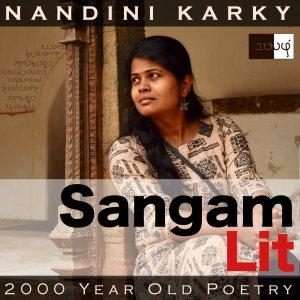Sangam Lit

Puranaanooru 90 – Assurance of victory
In this episode, we listen to words of encouragement rendered unto a king, as portrayed in Sangam Literary work, Puranaanooru 90, penned on the Velir king Athiyamaan Nedumaan Anji by the poet Avvaiyaar. The verse is set in the category of ‘Thumbai Thinai’ or ‘Battle of two kings’ and demonstrates how victory is sure to favour the king.
உடை வளை கடுப்ப மலர்ந்த காந்தள்
அடை மல்கு குளவியொடு கமழும் சாரல்,
மறப் புலி உடலின், மான் கணம் உளவோ?
மருளின விசும்பின் மாதிரத்து ஈண்டிய
இருளும் உண்டோ, ஞாயிறு சினவின்?
அச்சொடு தாக்கிப் பார் உற்று இங்கிய
பண்டச் சாகாட்டு ஆழ்ச்சி சொல்லிய,
வரி மணல் ஞெமர, கல் பக, நடக்கும்
பெருமிதப் பகட்டுக்குத் துறையும் உண்டோ?
எழுமரம் கடுக்கும் தாள் தோய் தடக் கை
வழு இல் வன் கை, மழவர் பெரும!
இரு நிலம் மண் கொண்டு சிலைக்கும்
பொருநரும் உளரோ, நீ களம் புகினே?
Poet Avvaiyaar renders rousing words to cheer the king into action in this verse. Her words can be translated as follows:
“In the mountain slope, fragrant with flame-lilies that bloom akin to opened conch shells and wild jasmines with dense leaves, when a fierce tiger roars aloud, can there be any deer that would stand against it? In the changing twilight sky, can there be darkness left in any direction when the sun rages? When the wheel of a wagon, owing to the weight of merchandise gets stuck in the muddy pit on the road, making river sand scatter, splitting rocks around, pull the proud bulls. Can there by any path that they cannot tread?
Akin to wooden bolts on fort doors, extend your sturdy hands that descend to your knees, flawless in their strength, O leader of the Mazhavars. Upon this wide earth, can there be any warrior left to win over your land, when you enter the battlefield?”
Let’s explore the messages within. The poet is intent on conveying encouragement to King Athiyamaan, who is about to enter the battlefield. She does this by depicting three different scenes from the outer world. In the first scene, we observe a mountainous region, at a lush slope where flame-lilies and jasmines are bursting into bloom. In this serene location, a tiger roars aloud, the poet details, and completes this scene with the rhetorical question about whether any deer in a herd can stand there unperturbed by that sound. Next, she moves up to the sky at the moment, when the sky is in some confusion about whether it’s blue or orange, at the break of dawn, and asks whether there can even be a drop of darkness when the sun decides to rise in fury. In the third and final scene, she brings before us an image of a wheel of a wagon stuck deep in the slush on a road because of all the merchandise being carried, and at this time, bulls are pulling the same with determination, and manage to free that wheel, making sand scatter in all direction and pebbles to break into smithereens. Can any road be impossible for these strong and proud bulls?, the poet asks.
From these scenes in the outer world, the poet turns to the king and describes his strong and flawless hands that hang down to his knees, a marker of masculine beauty in Sangam times, and asks him, akin to the situation in all the scenes above, can any enemy warrior stand tall and claim this king’s land when the king enters the field to battle against them. ‘Can there be?’ implying ‘a strong no’ is at the core of this verse. By talking about the immutable truths of nature and the world around, the poet declares likewise it’s impossible for the king to lose a fight. The evergreen truth about the impact of hearing words of positivity before beginning something is illustrated in this verse from two thousand years ago!






 Visit Podcast Website
Visit Podcast Website RSS Podcast Feed
RSS Podcast Feed Subscribe
Subscribe
 Add to MyCast
Add to MyCast